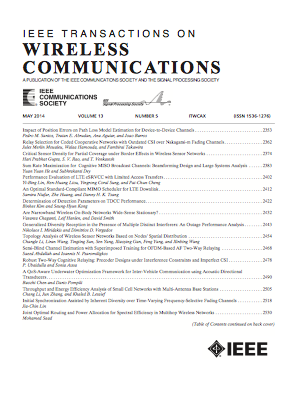THzCondenser: A System Design for IRS-Aided Terahertz Wideband Communications
IF 10.7
1区 计算机科学
Q1 ENGINEERING, ELECTRICAL & ELECTRONIC
引用次数: 0
Abstract
With the access to tens of gigahertz of bandwidth, terahertz (THz) wideband communication emerges as a promising technology for the upcoming next generation mobile networks. To deal with the severe path loss and blockage of THz signals, massive multiple-input multiple-output and intelligent reflecting surface (IRS) can be jointly employed. Due to the extremely large signal bandwidth, the beams generated by the transmit hybrid beamforming may point to different directions around the target direction at different frequencies, which results in the beam splitting effect (BSE). In this paper, a new system design namely THzCondenser is introduced to mitigate the BSE, where the signals generated by each transmit radio frequency (RF) chain are reflected by one of the distributed IRSs in a one-to-one manner via the joint transmit and IRS beamforming design, thus creating adjustable multi-path components to achieve both high spatial multiplexing gain and array gain. Moreover, for practical scenarios when the number of transmit RF chains is more than that of IRSs, each IRS may need to reflect the signals generated by multiple RF chains in a one-to-many manner. For the above two cases, the joint beamforming design problems are efficiently solved to maximize the achievable rate. Simulations are conducted to verify the effectiveness of the proposed algorithms for mitigating the BSE and improving the achievable rate in IRS-aided THz wideband communications.THzCondenser:一种irs辅助太赫兹宽带通信系统设计
随着对数十千兆赫带宽的访问,太赫兹(THz)宽带通信成为即将到来的下一代移动网络的一项有前途的技术。为了解决太赫兹信号严重的路径损耗和阻塞问题,可以采用大规模多输入多输出和智能反射面(IRS)相结合的方法。由于信号带宽非常大,发射混合波束形成产生的波束可能在不同频率下指向目标方向周围的不同方向,从而产生波束分裂效应(BSE)。本文介绍了一种新的系统设计,即THzCondenser,通过联合发射和IRS波束形成设计,将每条发射射频链产生的信号以一对一的方式反射到其中一个分布式IRS中,从而创建可调的多径组件,以实现高空间复用增益和阵列增益。此外,在实际场景中,当发射RF链的数量大于IRS的数量时,每个IRS可能需要以一对多的方式反映多个RF链产生的信号。针对上述两种情况,有效地解决了联合波束形成的设计问题,使可达速率最大化。通过仿真验证了所提算法在irs辅助太赫兹宽带通信中减轻BSE和提高可达速率的有效性。
本文章由计算机程序翻译,如有差异,请以英文原文为准。
求助全文
约1分钟内获得全文
求助全文
来源期刊
CiteScore
18.60
自引率
10.60%
发文量
708
审稿时长
5.6 months
期刊介绍:
The IEEE Transactions on Wireless Communications is a prestigious publication that showcases cutting-edge advancements in wireless communications. It welcomes both theoretical and practical contributions in various areas. The scope of the Transactions encompasses a wide range of topics, including modulation and coding, detection and estimation, propagation and channel characterization, and diversity techniques. The journal also emphasizes the physical and link layer communication aspects of network architectures and protocols.
The journal is open to papers on specific topics or non-traditional topics related to specific application areas. This includes simulation tools and methodologies, orthogonal frequency division multiplexing, MIMO systems, and wireless over optical technologies.
Overall, the IEEE Transactions on Wireless Communications serves as a platform for high-quality manuscripts that push the boundaries of wireless communications and contribute to advancements in the field.

 求助内容:
求助内容: 应助结果提醒方式:
应助结果提醒方式:


